“Translucent Ceramics,” Dr Dorothy Erickson
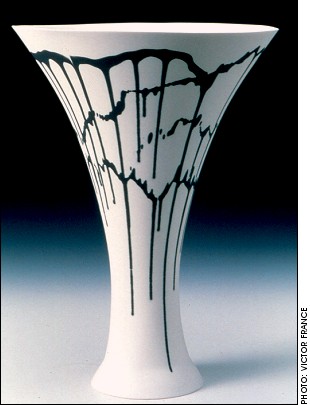
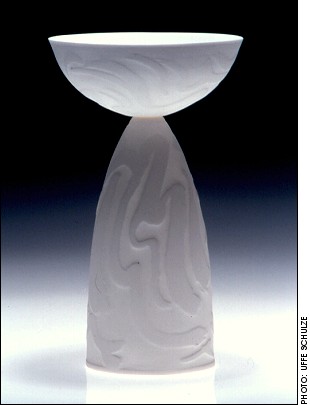
Bone china vessel, 1996, slip-cast, ht 18 cm
Bone china chalice, 1997, slip-cast, ht 17 cm
Exclusively fluid, organic forms in ultra-thin bone
china are the hallmark of Western Australian ceramic
artist Angela Mellor. Profile by Dr Dorothy Erickson.
VEGETATIVE slip-cast forms decorated with matt underglaze colours first brought Angela Mellor’s work to the notice of the Australian and European public. More recent monochromatic work contrasting organic detail with classical, flaring bell forms exploit the translucence of bone china. Mellor has had a lifelong interest in natural history subjects and much of her inspiration and original pastel palette is to be found in the minutiae of her surroundings.
Bark, lichen, a spider’s web, coral, shells, flowers, wings and the shadows on the wall opposite her kitchen window have inspired either form or decorative elements. Married since 1995 to mining engineer Manfred Dinse, she spends part of each year in Indonesia where the exotic tropical plants have been the inspiration for brighter colours in her palette. Marine life on the Australian coast is the inspiration for her current body of work.
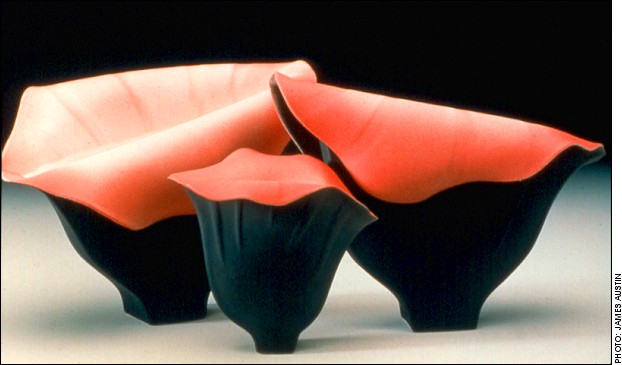
‘Lily’, 1995, slip-cast bone china vessel, tallest 18 cm
Angela Mellor, née Jackson, was born in 1945 in Cheshire, England, to Sydney Jackson and his wife Rose, née Dempsey. Her father died when she was one year old and so she grew up in a single-parent household. Deciding to make education her career, she undertook a teaching diploma in Art and Design at Manchester University, graduating with distinction in 1968. A short-lived marriage to Michael Mellor while still a student saw her commence her teaching career while raising two boys. It was not until 1984 that she had time to return to formal study, taking an advanced certificate in Education at the University of East Anglia. By this time she was exhibiting ceramics and studying with Peter Lane, the internationally-known author and potter. Teaching, however, remained her profession until 1991. Following an inspiring slip-casting workshop with English potter Sasha Wardell, in which she found her métier, Mellor reduced her teaching load to three days a week and made the transition to artist potter. Success soon followed with inclusion in exhibitions at the Victoria and Albert Museum in London and other prestigious venues in Europe.
Mellor's ceramic work had developed gradually as teaching was her major career. Exhibiting did not really commence until 1979, after she joined the Midland Potters’ Association in Staffordshire. The early work was hand-build stoneware, organic in form. Tree trunks, fern fronds and lilies were the main inspiration. These works were sawdust fired. Glazes did not interest her. The walls were as thin as the medium allowed, but she was not satisfied. An admirer of the tactile surfaces of Mary Rogers' work, she strove for the same delicacy. This led her to the work of Peter Lane and while studying with him she was captivated by the translucency of porcelain. Years of experimentation followed. Teaching at the Leys School in Cambridge from 1986-94 saw only a small amount of time available for her art.
Nonetheless, she exhibited in the UK and Europe, developing the individual slab-built black-and-white forms for which she became known. The forms were organic, often wave-like, with fine edges. Some had impressed plant decoration and were rubbed and sponged with ceramic stains. Work of this nature was reproduced in Peter Lane’s book Contemporary Porcelain in 1995. Elegant winged forms were developed and made in sculptural groups, usually of three sizes. However, the medium had its problems; they were not translucent enough and built works fired at high temperatures are prone to splitting, so a search was on for a new medium.
In 1991 she attended a short slip-casting course in France, studying under Sasha Wardell. Requested to bring a piece to cast, she took a small winged form (now known as Lily) to make a three-piece mould. The first cast of bone china was a revelation for Mellor and prompted her to reduce her teaching load to three days a week and embark upon her ceramic work in earnest.
She writes: “It was the ultimate whiteness, thinness and translucency of bone china, a close relative of porcelain, that attracted me to experiment with slip-cast forms. I find the tactile quality of bone china very appealing and its marble-like surface has a warm sensuality about it. Slip-casting allows me to make ultra-thin shapes which are extremely translucent, pure and so white that ordinary porcelain seems almost grey in comparison.”
Bone china cannot be thrown on a wheel, so more mould-making workshops were undertaken at Brunel University in 1993 and at Staffordshire University in 1994. If round forms are required, moulds have to be turned, so Mellor purchased a lathe. Striking black-and-white flaring chalice forms poured into single-piece moulds are made this way. The decorative imagery, derived from a spider web, is obtained by drizzling a fine black slip inside the mould and when it is set pouring in the white slip. The result is a striking and unique piece.
Mellor became a professional member of the Craftsmen Potters’ Association of Great Britain. her work was progressing well, she had learnt to alter the forms and manipulate the changes which occur in bone china in a heated kiln and she was exhibiting these in Europe when her sons set off to see the world and caused a chain reaction which brought her to Australia. For Christmas, 1993 she flew to Bali to join her boys. The tropical vegetation fascinated her. The exotic colours remained in her memory and produced the hues on the succulent wing-lily forms exhibited in Europe in 1995. More importantly, on the flight back home she met her future husband and a year later flew out to Perth to join him – bringing with her “a couple of gallons” of bone china slip. Bone china has an unusual characteristics in that, if setters are not used, it warps in the kiln in response to the heat and proximity to other forms. Each of the fine-edged lily forms deforms itself, if not already assisted by Mellor who encourages rim distortion and directs the process by filling the interior with alumina to avoid a pulling in or closing of the flower-like forms. The result has been a series of luscious pouting tropical flowers.
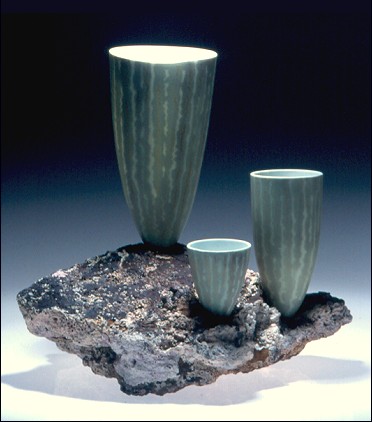
Coral Reef, 1998, slip-cast bone china, coral, ht 17 cm
Since moving to Australia Mellor has been able to concentrate on developing the ceramic forms and also to explore other directions. With her husband’s support she has pursued further studies at universities in Hobart and Melbourne. A Bachelor of Fine Arts Honour Research program at the University of Tasmania, Hobart in 1997 led to an exploration of organic forms and ceramic translucency that culminated in a new body of work called Light Forms. This new work investigated the translucency of bone china and its potential for the transmission of light. Pieces were decorated by either painting with soluble colourants or by relief decoration, using shellac resist and sponging away the still-damp clay.
Three exquisite up-light floor lamps and matching wall lights—prototypes for a production range—exploit the second of these methods. Photographs of shadows on her garden wall are translated into patterns of light and shade on the translucent china. The form was inspired by the datura or angels trumpet flowers. The style is a little reminiscent of the wheel-thrown porcelain of Norwegian Arne Åse whose work, like Les Blakeborough’s, has attracted her study. However, she is taking it further, working in slip-cast bone china and using insertions of paper clay to provide texture and design in crisp relief.
Mellor has been selected in a number of national exhibitions since arriving in Australia, including the 1986 Porcelain Exhibition at Perth Galleries and Mapping Identity. In 1998 five of her small bone china cups were exhibited in the prestigious Fifth International Ceramics Competition, held in Mino, the centre of Japan’s ceramic industry. Some 200 exhibitors from 52 countries were selected from the two thousand entries. Four were from Australia. Mellor’s entry in Mino, 1998 consisted of bone china cups in a black momagami box, which received an Honourable Mention. Similar work, titled Sake Cups Series II, is represented in the touring exhibition “Mapping Identity”, which opened at the Centre of Contemporary Craft in November, 1998 and will proceed around various States until 2000.
Having had little opportunity previously to visit the seashore, Mellor was fascinated by marine life in Tasmania and incorporated the textures found on the coastline into her work. She was also introduced to glass while in Tasmania and has cast glass bases for some of the ceramic forms. She hopes this will enable more light to enter the bone-china vessels. This new work is still in its formative stages but has resulted in her receiving a Monash Graduate Scholarship to research for her MA at Monash University, Melbourne. Using the seashore theme she intends to pursue the exploration of translucency by combining glass and bone china and is experimenting with nitrates painted on clay after the bisque firing to give a watercolour effect to the bone china. As she says, “The white, sensuous, smooth quality of bone china does not require a glaze, just a delicate hint of colour that will not obscure its translucency.” Mellor felt the need to extend the range of vessels that could stand as a group and to control the grouping. She therefore elected to join them together as sculptural forms set in a “wave” base of pâte de werre. Angela Mellor’s concerns are with the environment, light and space. Her current experiments into translucency and the seductive qualities of bone china will undoubtedly result in further intriguing work.
Dr Dorothy Erickson
Dr Dorothy Erickson exhibits jewellery worldwide and writes on art and design from her base in Perth, Western Australia.

'Bone China Cups in Black Momagami Box'. Award winner, Mino, 1998, Japan
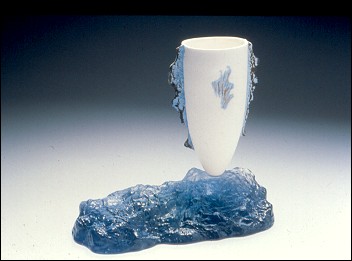
Bone china and glass, 1998
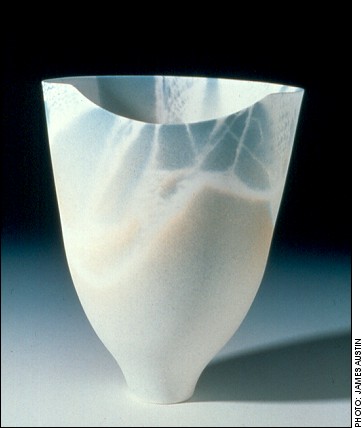
'Clouds', 1994, slip-cast bone china, ht 17 cm
< Back to Press articles | “Shaping the Future with Earth: World Ceramic Exposition Korea 2001,” Angela Mellor >










